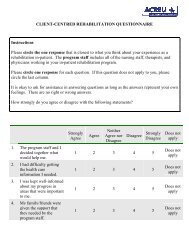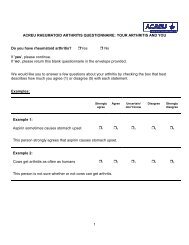Client-Centred Rehabilitation - Arthritis Community Research ...
Client-Centred Rehabilitation - Arthritis Community Research ...
Client-Centred Rehabilitation - Arthritis Community Research ...
You also want an ePaper? Increase the reach of your titles
YUMPU automatically turns print PDFs into web optimized ePapers that Google loves.
Appendix A: Canadian Occupational Performance Measure (COPM) – 1 st<br />
and 2 nd editions<br />
Developed by Law M, Baptiste S, Carswell-Opzoomer A, McColl MA, Polatajko H, Pollock N,<br />
1991. 2 nd Edition 1994.<br />
Purpose of COPM is "to enable occupational therapy clients to participate in a meaningful way in<br />
determining the course of occupational therapy intervention" (Law et al 1994)<br />
• Measure based on the model of occupational performance, and to meet ten criteria for an outcome<br />
measure as set by the 3 rd volume of the guidelines (Towards Outcome Measures)<br />
• individualised, standardised but not normative measure<br />
• for use with all age spans, all disability groups, all developmental levels; targets physical and/or<br />
mental disability in occupational performance (see Townsend 1997 for definition)<br />
• allows for proxy response when client unable to respond<br />
• measure of change in client's (or proxy's) perception of occupational performance; measures<br />
client identified problems/concerns/issues and considers client's satisfaction with performance,<br />
rating of importance and perception of current performance<br />
Process:<br />
Step1: Problem definition – client identifies specific things they are concerned with in the areas<br />
of self-care, leisure and productivity (e.g sitting, playing golf, operating machinery)<br />
Step 2: Weighting – client rates those concerns for importance on a 1-10 scale<br />
Step 3: Scoring – client chooses up to five of these problems that will be<br />
addressed and measured in COPM, and rates those five out of ten on how well they think<br />
they are currently performing that activity and how satisfied they are with that<br />
performance. Overall performance and satisfaction are calculated by weighting<br />
according to importance. Intervention usually occurs following this step.<br />
Step 4: Reassessment – client reassesses the same five problem areas as to how well they believe<br />
they are performing and how satisfied they are with that performance. These scores are then<br />
compared to the original.<br />
Step 5: Follow-up – the client is asked if there are problems remaining, or new problems that<br />
have emerged that they would like to address. If client wishes to continue intervention, process is<br />
begun again with a new COPM form.








